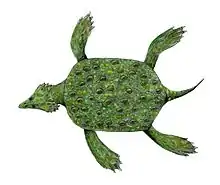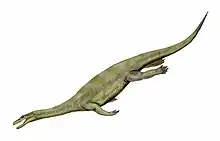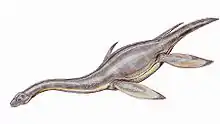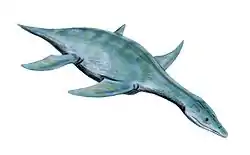Vinialesaurus
Vinialesaurus is a genus of plesiosaur from the Late Jurassic (Oxfordian) Jagua Formation of Pinar del Río, Cuba. The type species is Vinialesaurus caroli, first described as Cryptocleidus caroli by De la Torre and Rojas in 1949 under the holotype MNHNCu P 3008,[1] and redescribed by Gasparini, Bardet and Iturralde in 2002. The authors of the 2002 paper considered Vinialesaurus distinct enough from Cryptocleidus to warrant its own genus, but it was broadly similar to Cryptocleidus.[2]
| Vinialesaurus Temporal range: Oxfordian ~ | |
|---|---|
 | |
| Restoration | |
| Scientific classification | |
| Domain: | Eukaryota |
| Kingdom: | Animalia |
| Phylum: | Chordata |
| Class: | Reptilia |
| Superorder: | †Sauropterygia |
| Order: | †Plesiosauria |
| Family: | †Cryptoclididae |
| Genus: | †Vinialesaurus Gasparini et al., 2002 |
| Species: | †V. caroli |
| Binomial name | |
| †Vinialesaurus caroli Gasparini et al., 2002 | |
| Synonyms | |
| |
The name Vinialesaurus honors Viñales, the town in western Cuba where the fossils of Vinialesaurus was discovered. These fossils consist of a mostly complete skull, jaw, and portions of the vertebrae.[2]
It was a relatively small plesiosaur, reaching 3.5 m (11 ft) in length and 250 kg (550 lb) in body mass.[3]
References
- De la Torre & Rojas (1949). A new species and two subspecies of Ichthyosauria of the Jurassic of Vinales, Cuba. Memorias de la Sociedad Cubana de Historia Natural, vol. 19, n. 2, p. 197-200
- Gasparini, Z.; Bardet, N. & Iturralde-Vinent, M. (2002). "A new cryptoclidid plesiosaur from the Oxfordian (Late Jurassic) of Cuba". Geobios. 35 (2): 201–211. doi:10.1016/s0016-6995(02)00019-0. Archived from the original on 2010-07-02. Retrieved 2010-07-02.
- Paul, Gregory S. (2022). The Princeton Field Guide to Mesozoic Sea Reptiles. Princeton University Press. p. 113. ISBN 9780691193809.
External links
- Vinialesaurus in the Plesiosaur site






.png.webp)